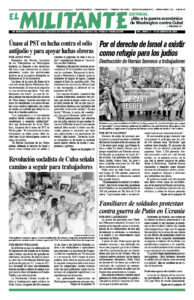Hamas is a murderous, reactionary and anti-working-class outfit whose founding covenant calls for wiping Israel off the face of the earth and the slaughter of all the Jews. It has become an increasingly central link in Tehran’s “axis of resistance.”
Hamas imposed a brutal dictatorship in Gaza after narrowly winning elections there in 2006. It is not only a deadly threat to Jews. It’s also the biggest obstacle Palestinian workers face in finding a way to collaborate in class battles with fellow workers from Israel as well as organizing to defend their own national interests.
Far from being an organization that fights for national liberation — as its apologists around the world claim — Hamas is an armed capitalist party with a financial empire across the Middle East that its leaders use to enrich themselves and help finance their murderous assaults, along with funds siphoned off U.N. aid directed toward Palestinians in Gaza.
The Wall Street Journal Jan. 4 reported that Hamas leaders own a portfolio with hundreds of millions of dollars in real estate assets and stakes in companies in Turkey, Algeria, Sudan and the United Arab Emirates. They cultivate relations with the governments of these countries and with Moscow.
In addition, the paper estimates that Hamas gets hundreds of millions of dollars from the government in Tehran, as well as millions from taxes it imposes on both legal and smuggled goods imported into Gaza. And Hamas apologists around the world find ways to funnel money to the group.
The Islamist group’s central leaders and their families live lives of luxury in Qatar, Turkey and elsewhere. Israeli government officials assert that Hamas leaders Moussa Abu Marzouk, Khaled Mashaal and Ismail Haniyeh, the current head of Hamas’ political bureau, are billionaires.
Some apologists of Hamas, like the author of a recent article in Eyerys, an Indonesia-based website, claim the charges of obscene wealth are exaggerations. But even that article had to admit that “the three leaders have been seen at Qatar’s diplomatic clubs, photographed inside private jets, stay at five-star hotels and mansions, dine at some of the Middle East’s best restaurants.”
Hamas leader Abu Marzouk was asked by Russia Today in October why Hamas has built hundreds of miles of tunnels, but not a single bomb shelter for civilians.
He said they have no responsibility for that. “It is the U.N.’s responsibility to protect them,” Marzouk argued, because “75% of the population of Gaza are refugees.”
The Israel Defense Forces estimate that Hamas used 6,000 tons of concrete and 1,800 tons of metal to build the tunnels. Some are 200 feet underground and include elevators, running water and electricity. Constructing them took thousands of hours of labor power over years and tens of millions of dollars, resources that could have been invested in extending waterlines, building factories and power generation, increasing agricultural production, and constructing decent housing to improve the lives of people in Gaza.
But that has never been the goal of Hamas.

